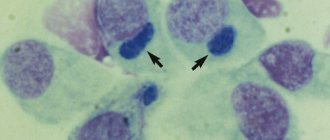What is mycoplasmosis in dogs?
In dogs, the disease occurs when infected with the smallest single-celled microorganisms Mycoplasma canis. Pathogens lack a cell wall (but are protected by a special shell) and therefore can take on different shapes. This feature allows them to freely penetrate the bacterial filters of the pet’s body. Cells contain DNA and RNA (which distinguishes them from viruses) and do not form spores.
The pathogen is localized mainly on the mucous membranes. Penetrating into the body, the microorganism fills the intracellular space and merges with the cell of the host organism. During their life, they do not release heavy toxins, but only small amounts of hydrogen peroxide and ammonia, which have an adverse effect on tissue.
Description
Mycoplasmas are often contained in the permanent flora of the mucous membranes of the upper respiratory tract, genital organs, and gastrointestinal tract in 70-80% of dogs. However, only 10% of carriers develop the disease. Infection, covering different parts of the body and organ systems, occurs with immunity deficiency, its suppression, and oncology.
By attaching to the host cell, mycoplasmas feed at its expense and obtain useful substances necessary for growth. “By masquerading,” they disrupt the process of recognizing substances and cells foreign to the body. This can cause an immune response to attack your own body (autoimmune process).
Mycoplasmosis is often accompanied by a secondary infection caused by bacteria. In this case, exudate with a large amount of fibrinogen is released, which protects mycoplasmas from attack by antibodies and the action of antimicrobial drugs. Therefore, it is difficult to treat the disease. Often it becomes chronic.
Pathological conditions develop under the influence of mycoplasma waste products. The infectious process spreads to the respiratory system, mammary glands, joints, genitals, nervous system, and urinary tract.
The disease affects both small and medium-sized dogs (Spitz, Pugs, etc.) and large ones (Labradors, Rottweilers, German Shepherds, etc.).
Forms of the disease
Mycoplasma infections can occur in an acute form, but more often they have a chronic, relapsing course.
Mycoplasmas have mechanisms that ensure long-term persistence (preservation) in the body:
- The pathogen is able to merge with the membranes of host cells, which prevents its mechanical elimination (with urine, mucus). Such a tight connection makes it difficult for the immune system to recognize and act on a foreign agent.
- The microorganism can exchange lipids and antigens with the affected cell. In this case, the pet’s immune system perceives the mycoplasma wall as its own.
Pathogen
Mycoplasmosis in dogs can be caused by a whole group of microorganisms of the class Mollicutes . These microorganisms are the simplest prokaryotes, measuring only 0.2 microns . All microorganisms of this class are divided into three groups:
- Mycoplasmas.
- Ureaplasma.
- Acholeplasmas.
Mycoplasmas are found everywhere, regardless of continent and climate; moreover, they can be part of the microflora of the upper respiratory and reproductive tract of any animal. Once in the body, they adhere tightly to the cells of the host carrier and begin to receive nutrients from it; during their life, they release ammonia and hydrogen peroxide, which leads to disruption of the functions of healthy cells and tissue damage.
If mycoplasmas find themselves in conditions that are unsuitable for them, they quickly die. As a rule, these microorganisms are very species-specific, that is, their different types are dangerous only to specific animals, but scientists still cannot come to a common opinion about whether a person can become infected with mycoplasmosis from dogs.
What type of mycoplasma is dangerous for dogs?
The most dangerous is Mycoplasma cynos, canis. And although it has been proven that microorganisms of these types can remain in the body for a long time without causing any harm to health, responsible owners are obliged to pay enough attention to strengthening the pet’s immunity, in particular, vaccination on schedule. Since mycoplasmas are opportunistic pathogens (organisms that can cause diseases only when certain negative factors coincide), stress, any infectious disease, immunodeficiency and even poor nutrition will lead to the development of mycoplasmosis. Close contact with other animals (especially if they live in enclosures) is also dangerous.
Interesting to know! Studies have proven that if a dog has a strong immune system, eats well and takes vitamin supplements, then infection will not lead to any serious consequences.
You should contact your veterinarian for testing for the presence of pathogenic bacteria if:
- a pregnant bitch is diagnosed with fetal resorption;
- the pet had close contact with mongrels;
- the animal regularly suffers from respiratory diseases.
What is mycoplasmosis
Mycoplasma does not have a cell membrane. Therefore, this microorganism is classified as a separate prokaryotic class Mollicutes. It is not a bacteria, fungus or virus . Found everywhere: in soil, water, on plants. However, it can only live in a favorable environment, joining cells. Mycoplasmosis is transmitted in dogs only from an infected individual.
The main carriers of mycoplasmosis are rats and cats. Moreover, cats, in addition to microorganisms of “their” type Mollicutes felis and Mollicutes gatae, carry Mollicutes cynos, which is not dangerous for them, but affects dogs.
The disease is transmitted in several ways:
- airborne;
- contact;
- sexual;
- generic
In the animal's body, the habitat of microorganisms is the mucous membranes of the upper respiratory tract, gastrointestinal tract, and genital organs.
Mycoplasmas are present in 80% of animals, but only 10% of cases develop the disease. This happens when the body’s defenses are weakened, during pregnancy, cancer, and immunodeficiency.
How dangerous is this disease?
Since mycoplasmas are often found in the external environment and can be present in the normal microflora of a pet, the pathological development of the microorganism depends on the host’s resistance to infection. The weaker the body, the more severe the disease.
The localization of the pathological process depends on the entrance gate of the infection, that is, on the organ or tissue where the microorganism entered during infection and began to develop successfully there.
Mycoplasmas can affect such important cells as lymphocytes, erythrocytes, and sperm. During life, they spread throughout the body, causing systemic damage. Most often, the organs of the genitourinary system are affected (leading to infertility of both females and males), the musculoskeletal system, the respiratory tract, the liver, and the kidneys.
Some microorganisms are able to penetrate host cells and change their structure. In this case, the body begins to perceive these cells as foreign, and an autoimmune process develops. The mutagenic effect of mycoplasmas has been proven.
Signs that mycoplasmosis has appeared in dogs
To understand whether a dog is suffering from mycoplasmosis, you need to pay close attention to the signs. The main symptoms of mycoplasmosis in dogs are in most cases pronounced, for example:
- elevated temperature, signs of fever;
- the dog is feeling unwell;
- reluctance to make contact with the owner, ignoring affection;
- lack of appetite, diarrhea, severe stomach pain, colic;
- inflammation of the eyes, eyelids, accompanied by purulent discharge;
- the appearance of a rash or spots on the dog’s skin, they are especially noticeable and there may be no hair at the site of the lesion;
- runny nose, cold symptoms that can develop into inflammation of the lungs and bronchi;
- lameness that occurs due to deterioration of the joints;
- parainfluenza;
- rhinitis or inflammation of the nasal cavity;
- prostatitis, signs of cystitis.
To prevent the disease from getting worse and leading to irreversible consequences, you must pay close attention to the symptoms and contact a veterinarian. The doctor will establish an examination regimen, and only after that will prescribe treatment. To identify the disease, you must first check the blood and urine, then the respiratory tract is examined, and the eyes are checked.
Once mycoplasmas have been identified, it is necessary to establish their resistance and approximate quantity. Such indicators will give an idea of the disease, its characteristic features and at what stage the disease is. To achieve results and effective treatment, you need to contact a veterinarian on time and follow all instructions.
No one other than a veterinarian can accurately determine the cause of the disease and how to treat it. Sometimes, symptoms may indicate mycoplasmosis, and test results will reveal another disease.
The importance of early diagnosis and proper treatment of mycoplasmosis in dogs
Mycoplasmosis in dogs is a serious disease that is important to recognize promptly and choose the right treatment. You cannot do without going to a veterinary clinic for help from a doctor, but suspecting something wrong in time is the responsibility of the dog owner. Below it is written in detail for which ailments you should immediately consult a doctor, what dog behavior indicates the likelihood of illness, and explanations of why you should not self-medicate.
We recommend reading: Parasites Transmitted from Cats to Humans
Routes of infection
It is very easy to become infected with mycoplasmosis; pathogens are transmitted by airborne droplets, contact, feed, sexual and birth tracts. However, infection with mycoplasmosis does not necessarily mean that the animal will get sick; if the dog does not have chronic diseases, cancer pathologies and a sufficiently strong immune system, then the disease will not manifest itself.
If the pathology does manifest itself, the consequences for the dog can be very bad, including infertility, spontaneous abortions in bitches and chronic diseases of the musculoskeletal system.
Is it transmitted to humans?
Personal hygiene should be maintained.
Many people are interested in the question: “Is mycoplasmosis transmitted from dogs to humans?” It is impossible to get infected from a pet , since the mycoplasma that lives in humans is a completely different type. But personal and household hygiene should be adhered to. This will allow you to quickly cure your four-legged pet.
Causes of the disease and routes of transmission of mycoplasmosis in dogs
It was mentioned above that mycoplasmas are part of the normal microflora of an animal, so the disease will manifest itself only if the immune system is weakened.
When an opportunistic pathogen enters the body of an animal, the mycoplasma interacts with its cell, then the microorganism feeds at the expense of the host, in our case the dog. As a result of living in the body, bacteria produce hydrogen peroxide and hydrogen nitride. The release of these chemicals disrupts the proper functioning of a healthy cell.
Not only dogs can suffer from mycoplasmosis. Humans, plants, and insects are also susceptible to this disease.
Ways of infection with mycoplasmosis:
- aerosol (airborne);
- contact (sexual, direct contact or household contact);
- nutritional (food and water);
- blood contact (blood transfusion route, transmissible route).
Mycoplasmas are not transmitted transplacentally, but puppies are infected in the first days of life through mother's milk.
Mycoplasma canis is not always contagious. If your pet has a strong immune system and does not have cancer or chronic diseases, then pathology will not appear. If the body is weakened due to: viral, bacterial, parasitic, oncological diseases, pregnancy, stress and unfavorable living conditions, then the following picture may occur:
- conjunctivitis;
- damage to the respiratory system;
- diseases of the musculoskeletal system;
- postpartum diseases in bitches;
- diseases of the genitourinary system;
- pathological changes in the liver and kidneys.
If a pregnant dog gets sick with mycoplasmosis, then one should expect sad consequences: infertility, stillbirth, miscarriage, birth of diseased fetuses.
The main question that owners of sick animals ask is whether it is possible to get infected from a dog, and can mycoplasmosis be transmitted to humans?
It is believed that mycoplasmosis in humans and dogs is caused by different types of pathogens (mycoplasmas), so it is impossible for a person to become infected from a dog. But when in contact with sick dogs, you should follow the rules of personal hygiene.
Mycoplasma hominis (mycoplasma hominis) is not found in dogs; this species is characteristic only of humans.
Symptoms
For a long time, mycoplasmosis occurs in the dog’s body without symptoms, and it is impossible to find out about its presence, and if it begins to manifest itself, it is expressed in the occurrence of specific diseases in the pet.
Mycoplasmosis can manifest itself in diseases such as:
- Respiratory diseases.
- Pneumonia.
- Cystitis.
- Vaginitis.
- Nephritis.
- Urethritis.
- Balanoposthitis.
- Colitis.
- Arthritis.
- Arthrosis.
The initial symptoms of the disease will be: fever, apathy, general weakness, vomiting and diarrhea, rhinitis, sinusitis, conjunctivitis (increased lacrimation, swelling of the eyelids, purulent discharge). The dog may also develop suppuration on the skin and abscesses; The pet may experience periodic lameness and urinary incontinence.
Sometimes the only clear symptom is anemia , and the rest of the symptoms are absent or are too vague and uncharacteristic, which makes diagnosis difficult.
If a bitch was infected with mycoplasmosis during pregnancy, then there is a high probability of miscarriage, mummification and resorption of the embryos, or the birth of non-viable puppies.
Often a secondary infection is associated with mycoplasmosis, thus the microorganisms receive protection from antibacterial therapy. If this happens, the disease becomes chronic.
Diagnostics
In the treatment of mycoplasmosis, early diagnosis . To do this, a clinical examination of the pet is initially carried out, followed by a clinical and biochemical blood test, serological tests, a clinical urine test, eye swabs, swabs from the bronchi and mucous membranes of the genitourinary organs, and a test for fluorescent antibodies. The diagnosis of mycoplasmosis is not made on the basis of just one analysis, since this disease is differentiated from infectious diseases of the upper respiratory tract, infections of the genitourinary system, endocrine diseases, and arthritis.
Methods for diagnosing the disease
Due to the lack of a specific clinical picture, diagnosing mycoplasmosis in dogs is difficult. The doctor can take measures to cure or stop the underlying disease, while the mycoplasmas will continue to function in the animal’s body.
In addition to general diagnostic methods (blood tests, ultrasound, radiography), specific laboratory methods include:
- PCR is the most important and indicative test for mycoplasmosis. Washings are taken with a sterile cotton swab from the conjunctiva, nose, pharynx, and urogenital areas.
- Immunofluorescence reaction (RIF).
- Detection of antibodies by ELISA. This method is not very informative and is rarely used to identify mycoplasmas.
- Sowing on nutrient media to determine the sensitivity of the microorganism to various antibacterial drugs.
Mycoplasmosis
Colpitis
Cystitis
Pyelonephritis
11246 January 20
IMPORTANT!
The information in this section cannot be used for self-diagnosis and self-treatment.
In case of pain or other exacerbation of the disease, diagnostic tests should be prescribed only by the attending physician. To make a diagnosis and properly prescribe treatment, you should contact your doctor. Synonyms: mycoplasma infection, mycoplasma, Mycoplasma
Mycoplasmosis: causes, symptoms, diagnosis and treatment methods.
Definition
Mycoplasma infection is an acute disease caused by gram-negative bacteria, accompanied by various inflammatory lesions of the respiratory, urogenital tracts, joints, hematopoietic and nervous systems.
The causative agents are mycoplasmas from the genus Mycoplasma
of the family
Mycoplasmataceae
.
Mycoplasmas are unstable in the external environment and are destroyed by temperature, freezing, ultraviolet radiation, ultrasound, as well as modern detergents and disinfectants.
Mycoplasmas can exist not only outside, but also inside cells, which allows them to evade the body's immune defense mechanisms. Unlike bacteria, they do not have a cell wall, but can grow on special cell-free media. Like viruses, they pass through bacterial filters. Mycoplasmas cannot exist independently, since they parasitize the cells of the host organism, receiving nutrients from them.
Causes of mycoplasmosis
The source of infection is a sick person or a carrier of mycoplasmas. As a rule, mycoplasmosis occurs latently - approximately 40% of patients do not feel any obvious symptoms until a stressful situation or weakened immunity triggers the activation of the infectious process, often leading to serious complications.
Infection occurs by airborne droplets, sexually, vertically (from mother to fetus through the placenta) or during childbirth.
Respiratory mycoplasmosis caused by Mycoplasma pneumoniae
and transmitted by airborne droplets, makes up from 7% to 21% in the structure of acute respiratory diseases, ranking 5th among respiratory diseases.
Transmission of the pathogen requires fairly close and prolonged contact, which is why respiratory mycoplasmosis is especially common in closed communities.
The causative agents of respiratory mycoplasmosis enter the body through the respiratory tract and are fixed on the surface of the epithelium of the mucous membrane of the trachea and bronchi. They produce toxins that cause a persistent cough. The immunological response to this pathogen can provoke community-acquired pneumonia, severe upper respiratory tract diseases, and an acute asthma attack.
Numerous studies have shown that respiratory mycoplasmosis bacteria can be detected in almost all organs and tissues - liver, kidneys, heart muscle, brain matter, pericardial and intra-articular fluids, blood.
This makes it possible to consider mycoplasma infection as a generalized process with dissemination of the pathogen and the development of multiple organ lesions.
Mycoplasma genitalium
– a pathogenic microorganism that can cause urethritis in both sexes, cervicitis and inflammatory diseases of the pelvic organs in women. Urogenital mycoplasmosis is common among adults and is sexually transmitted.
Classification of the disease
There are three main forms of the disease: respiratory mycoplasmosis, urogenital mycoplasmosis, congenital mycoplasmosis.
Classification according to ICD 10
A63.8 Other specified diseases transmitted primarily through sexual contact:
- A63.8 + N34.1 Urethritis caused by M. genitalium
- A63.8 + N72 Cervicitis caused by M. genitalium
- A63.8 + N70 Salpingoophoritis caused by M. genitalium
- A63.8 + N71 Endometritis caused by M. genitalium
- A63.8 + N45 Orchitis and epididymitis caused by M. genitalium
- A63.8 + N48.1 Balanoposthitis caused by M. genitalium
J15.7 Pneumonia caused by M. pneumoniae
J20.0 Acute bronchitis caused by M. pneumoniae
B96.0 M. pneumoniae as a cause of diseases classified elsewhere.
Symptoms of mycoplasmosis
For urogenital mycoplasmosis, characteristic clinical features have not been identified. Mycoplasma urethritis, prostatitis, vaginitis, colpitis, cervicitis, acute and chronic pyelonephritis have been described. Most often, mycoplasmosis occurs in the form of a common genitourinary infection. There is itching and burning when urinating, pain in the lower abdomen, as well as light mucous discharge with an unpleasant odor.
A more severe case is respiratory mycoplasmosis, since absolutely any part of the respiratory tract can be affected.
The disease can occur in two clinical forms:
- mycoplasmosis of the upper respiratory tract (uncomplicated respiratory mycoplasmosis),
- mycoplasma pneumonia.
The mild form includes mycoplasmosis of the upper respiratory tract (pharyngitis, tracheitis).
The moderate form is characterized by the presence of mycoplasmosis of the upper respiratory tract with a clinical picture of obstructive bronchitis or mycoplasma pneumonia (interstitial, focal). The severe form of the disease occurs with severe and prolonged fever; typical for macrofocal, or “total” pneumonia.
The onset of the disease is often gradual, less often acute. Patients present with a sore throat, rhinitis, nonproductive persistent cough, low-grade fever, malaise, aching sensation, headache, hoarseness, rash, and rarely bullous inflammation of the eardrum. Catarrhal syndrome is characterized by symptoms of pharyngitis, tracheitis or bronchitis (often with an obstructive component). Children often experience a whooping cough, accompanied by pain in the chest and abdomen, often ending in vomiting.
Diagnosis of mycoplasmosis
The main direction in the diagnosis of mycoplasmosis is the isolation of the pathogen, since the clinical picture of the disease does not allow a reliable diagnosis.
Laboratory diagnosis of respiratory mycoplasmosis is based on direct methods for identifying mycoplasmas and serological tests for determining specific antibodies.
Conduct a serological test for M. pneumoniae
(for specific antibodies IgM, IgG and IgA). IgM antibodies are an indicator of primary infection.
Treatment
Mycoplasmosis is very resistant to many antibodies and bacterial therapies, so treatment is often very lengthy and difficult. As a rule, treatment is carried out with the following drugs:
- Antibiotics – aminoglycosides, tetracyclines (for dogs older than 6 months), tylosin, erythromycin, cephalosporins.
- Antimicrobial drugs: fluorochtnolones, macrolides, chloramphenicol, doxycyline.
- Immunomodulators are prescribed to increase the body's ability to fight the disease.
- Local antibacterial therapy for conjunctivitis, skin suppuration.
- Hepatoprotectors - to protect the liver.
Due to the resistance and rapid adaptability of mycoplasmas, antibiotics are quite difficult to choose , so they may change depending on the body's response to treatment.
If the bitch was infected during pregnancy, then treatment is not carried out until the birth of the puppies; the bitch is not allowed to give birth on her own, but a cesarean section is performed to prevent the puppies from becoming infected with mycoplasmosis and to prevent them from developing pneumonia, which will lead to the death of the newborns.
Since the disease is very insidious, at the slightest suspicion it is recommended to have it examined by a veterinarian.
Despite the complexity of diagnosis and treatment, with proper antibiotic therapy and a strong immune system, the prognosis for dogs is favorable.
Treatment at home
If you detect at least a few of the symptoms listed above, go to the clinic, where they will conduct diagnostic tests and prescribe treatment. Self-medication can lead to a momentary improvement in the dog’s condition, but the disease becomes chronic and, with a high degree of probability, lifelong. Do not attempt to treat a female puppy. The risk of puppies appearing with congenital deformities or non-viable ones increases.
Therefore, at home, your task is to follow the orders of the veterinarian.
Treatment at a veterinary clinic
The clinic conducts tests, gives the first injections and prescribes treatment. If mycoplasmosis is diagnosed in a pregnant bitch, but you want to keep the puppies, a cesarean section is performed. Pregnant dogs cannot be treated with antibiotics, for the reason I mentioned above. The cubs are weakened by the inflammatory processes occurring in the uterus and are at risk of infection during passage through the birth canal.
Prevention
Unfortunately, a vaccine against mycoplasmosis has not been developed, but microorganisms quickly die at high temperatures, direct sunlight and disinfection with chemicals. Since the disease is very complex, it is important to carry out maximum prevention in order to prevent the development of this disease in the dog. The best prevention would be:
- Balanced diet.
- Decent living conditions.
- Taking care of your immune system.
- Avoiding hypothermia.
- Avoiding stress.
- Avoid contact with stray animals.
- Timely vaccination of the animal.
- Prevention of helminthic infestations.
- Examination of both partners for mycoplasmosis before mating.
- Regular preventative examinations at the veterinarian.
Will self-medication help?
And the most important rule is never self-medicate, as this can only worsen the situation and accelerate the disease. And even after you feel better and have no symptoms, it does not mean complete recovery, since the disease can become chronic.
The chronic stage of the disease is more dangerous, since symptoms do not appear but destroy the pet. Attentive and caring attitude towards your pet is the key to health and well-being. Remember that the pet’s health is in the owner’s hands, and a caring owner is a dog’s best friend.
Prevention of mycoplasma infection
For cystitis and inflammation of the urinary system, anti-inflammatory medications are used. In case of eye inflammation, use both ointments and drops. Treatment may take an indefinite amount of time, so be prepared for this. To prevent the disease from progressing and affecting your pet, it is necessary to take preventive measures:
- regular veterinarian visits, mandatory preventive vaccinations;
- it is necessary to buy only high-quality food, rich in vitamins and minerals, because dogs with weakened immune systems suffer from the disease more often than others;
- restriction in communication with other animals, since when a healthy dog is infected, these manifestations may not be noticeable for a long time;
- During pregnancy, careful monitoring of the pet’s condition is necessary, since mycoplasmosis is inherited.
Mycoplasmosis in dogs is a dangerous disease, and if it progresses, new diseases such as distemper and enteritis appear. These diseases are severe and most often result in irreversible consequences for the animal. Pregnant dogs are especially vulnerable in this regard, so there is practically no chance of giving birth to healthy offspring. Mycoplasmosis in a pregnant female can lead to miscarriage, difficult childbirth and irreversible consequences.
Will self-medication help?
And the most important rule is never self-medicate, as this can only worsen the situation and accelerate the disease. And even after you feel better and have no symptoms, it does not mean complete recovery, since the disease can become chronic.
The chronic stage of the disease is more dangerous, since symptoms do not appear but destroy the pet. Attentive and caring attitude towards your pet is the key to health and well-being. Remember that the pet’s health is in the owner’s hands, and a caring owner is a dog’s best friend.
Currently reading:
- Seven Signs and Remedies for Getting Rid of Fleas in Dogs
- What to do if your dog has an abnormal bite
- Methods for killing scabies mites in dogs
- Is it worth it or not to include natural food in your dog’s diet?
Is mycoplasmosis in dogs transmitted to humans?
Canine mycoplasmosis is not dangerous for the animal owner. The disease also occurs in humans, but the pathogen has a different specificity. That is, canine mycoplasma cannot exist in the human body.
Mycoplasmosis is an unpleasant pet disease that occurs in a chronic form in most animals. However, a full diagnosis should be carried out if there are at least some suspicious symptoms. Treatment of the pathology is lengthy and does not always guarantee a complete recovery of the pet. Mycoplasmosis in dogs is not contagious to humans, but is easily transmitted to other animals.
Sources
- https://dogworry.ru/veterinariya/mikoplazmoz-u-sobak-simptomy-lechenie.html
- https://Bobik.online/healf/disease/mikoplazmoz.html
- https://sobakainfo.ru/mikoplazmoz-u-sobak-simptomy-lechenie-peredaetsya-li-cheloveku/
- https://usatiki.ru/mikoplazmoz-u-sobak-simptomy-i-lechenie/
- https://RealPet.ru/zdorovie/mikoplazmoz-u-sobak.html
- https://mykoshka.ru/lechenie-mikoplazmoza-u-sobak/
- https://MirSobak.net/vet-spravochnik/zabolevaniya/mikoplazmoz.html
- https://usobaki.com/mikoplazmoz-u-sobaki/
- https://dalmspb.com/zdorovie/mikoplazmoz-u-sobak-prichiny-simptomy-i-lechenie-124490/
[collapse]
Mycoplasmosis in dogs: symptoms, treatment and prevention
Mycoplasmas are insidious opportunistic microorganisms that are neither bacteria nor viruses. Unfortunately, mycoplasmosis in dogs is difficult and long to treat, especially if the disease is advanced. Therefore, it is important to detect parasites as early as possible in order to begin therapy before a serious disruption in the pet’s immune system.
Mycoplasmas live literally everywhere - in water, in soil, on grass and soil. But in unsuitable conditions, they quickly weaken and die, so infection most often occurs through direct contact with the carrier. This could be a person, cat, dog or other warm-blooded animal. Mycoplasmas are species-specific: different types are dangerous for different animals, but dog parasites can live in a cat’s body without causing harm to it (i.e. the cat is healthy, but can infect dogs).
It is not entirely clear whether mycoplasmosis is transmitted to humans from dogs. Most scientists believe that this is impossible, because... In humans, the disease is caused by another type of microorganism. However, veterinarians recommend following the rules of personal hygiene when interacting with a sick dog, especially if there are small children, old people, or people with immune diseases in the house. In addition to direct contact between healthy and sick animals, mycoplasmosis is transmitted from the bitch to the puppies during childbirth, when the fetus passes through the birth canal. Internal causes can also give impetus to the development of the disease - stress, hypothermia, immune breakdown.











